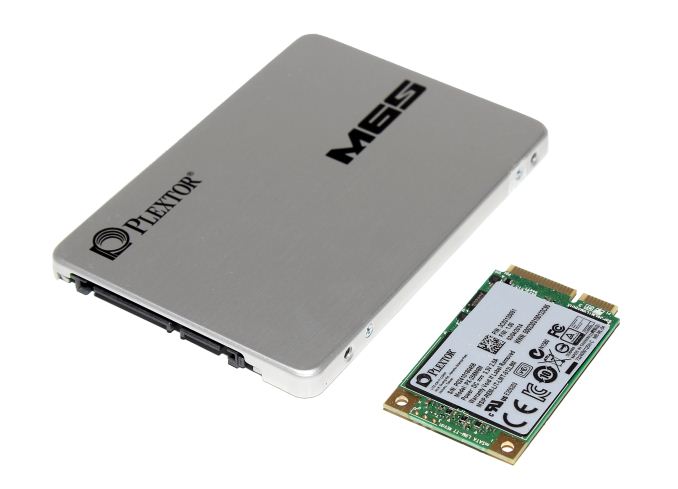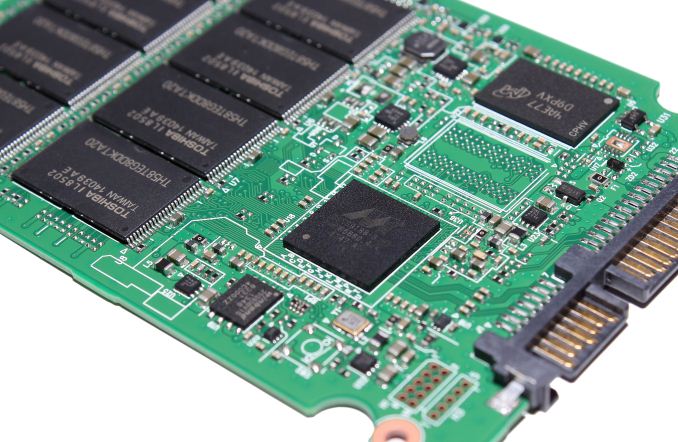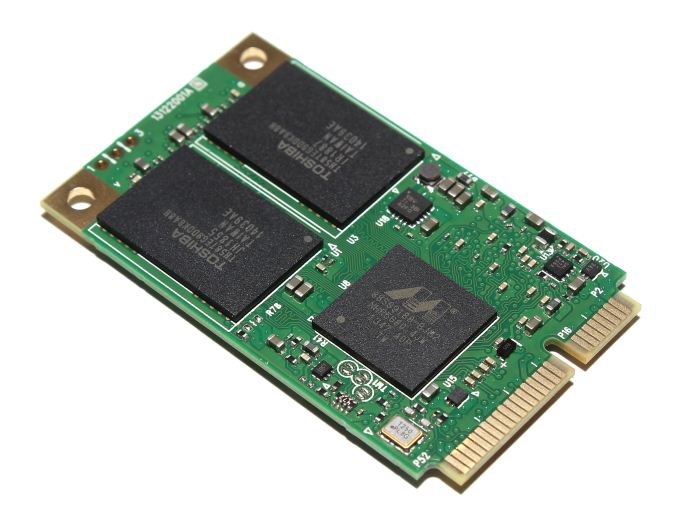Plextor M6S & M6M (256GB) Review
by Kristian Vättö on April 10, 2014 6:00 AM EST
Continuing our spring full of SSDs, the next drives under the scope are Plextor's M6S and M6M. Both drives were already showcased at CES this year but after a series of delays the release was pushed to April, which brings us to this review. Similar to the M5 series, the M6S is Plextor's mainstream offering with a focus on price, whereas the M6M is the mSATA variant of the M6S. The M5M was actually derived from the M5 Pro, so in this regard Plextor has slightly modified their strategy but I'm guessing this is to make the M6M more competitive in price. There will be an M6 Pro as well later this year and we'll probably know more after Computex (Plextor said June/July).
Photography by Juha Kokkonen
The biggest changes the M6S and M6M bring is Marvell's 88SS9188 controller and Toshiba's second generation 19nm MLC NAND. I'll cover the NAND in more detail in just a bit but the 9188 controller is essentially a "lite" version of the 9187 found in drives like the M5 Pro and Crucial M550. The amount of channels has been cut from eight to four, which is typical for budget and low power designs. We saw a similar trend with Marvell's previous generation 917x controllers where the 9174 was the full blown 8-channel design with 9175 being the cut down derivative. I believe the main market for the 9188 is mSATA drives because the spec only allows four NAND packages anyway, but Plextor has decided to use the 9188 controller in both the M6S and M6M.
| Plextor M6S Specifications | |||
| Capacity | 128GB | 256GB | 512GB |
| Controller | Marvell 88SS9188 | ||
| NAND | Toshiba A19nm MLC | ||
| Cache | 256MB | 512MB | 768MB |
| Sequential Read | 520MB/s | 520MB/s | 520MB/s |
| Sequential Write | 300MB/s | 420MB/s | 440MB/s |
| 4KB Random Read | 88K IOPS | 90K IOPS | 94K IOPS |
| 4KB Random Write | 75K IOPS | 80K IOPS | 80K IOPS |
| Endurance | 72TB (~66GB/day) | ||
| Warranty | Three years | ||
In terms of performance, there isn't any noticeable difference between the M6S and M6M. Similar to Crucial, Plextor is using 64Gbit die in the smaller capacity drives (see the table below for details) and 128Gbit in the larger ones. I covered this in the M550 review but in short the usage of smaller die increases parallelism, which in turn increases performance. For small drives the 128Gbit die is too large in capacity and the limited parallelism would lead to slow write speeds as we saw with the M500.
| Plextor M6M Specifications | ||||
| Capacity | 64GB | 128GB | 256GB | 512GB |
| Controller | Marvell 88SS9188 | |||
| NAND | Toshiba A19nm MLC | |||
| Cache | 128MB | 256MB | 512MB | 768MB |
| Sequential Read | 520MB/s | 520MB/s | 520MB/s | 520MB/s |
| Sequential Write | 160MB/s | 340MB/s | 440MB/s | 440MB/s |
| 4KB Random Read | 73K IOPS | 90K IOPS | 94K IOPS | 94K IOPS |
| 4KB Random Write | 42K IOPS | 76K IOPS | 80K IOPS | 80K IOPS |
| Endurance | 72TB (66GB/day) | |||
| Warranty | Three years | |||
Unfortunately, there is no hardware encryption support. This seems to be a feature that only a few manufacturers consider important for client drives, although I disagree because the value of the data we are carrying around is constantly increasing.
| M6S | M6M | ||||||
| Capacity | 128GB | 256GB | 512GB | 64GB | 128GB | 256GB | 512GB |
| # of NAND Packages | 8 | 8 | 8 | 4 | 4 | 4 | 4 |
| # of Die per Package | 2 x 8GB | 4 x 8GB | 4 x 16GB | 2 x 8GB | 4 x 8GB | 4 x 16GB | 8 x 16GB |
There is no NAND level redundancy either, which is also becoming a standard. The need for redundancy of course depends on the NAND and its reliability, but as we move to smaller lithographies it'll certainly be important to have some level of protection against page/block level failures. Plextor does have fairly strict quality control, though, as every drive is tested for at least 48 continuous hours including idle and power cycling tests (which are often what causes issues). Such rigid testing can make NAND redundancy less needed but I'd still like to have at least some redundancy just in case.
Test System
| CPU |
Intel Core i5-2500K running at 3.3GHz (Turbo and EIST enabled) |
| Motherboard | AsRock Z68 Pro3 |
| Chipset | Intel Z68 |
| Chipset Drivers | Intel 9.1.1.1015 + Intel RST 10.2 |
| Memory | G.Skill RipjawsX DDR3-1600 4 x 8GB (9-9-9-24) |
| Video Card |
Palit GeForce GTX 770 JetStream 2GB GDDR5 (1150MHz core clock; 3505MHz GDDR5 effective) |
| Video Drivers | NVIDIA GeForce 332.21 WHQL |
| Desktop Resolution | 1920 x 1080 |
| OS | Windows 7 x64 |
Thanks to G.Skill for the RipjawsX 32GB DDR3 DRAM kit












30 Comments
View All Comments
Kristian Vättö - Friday, April 11, 2014 - link
Yes, there will be a review of the M6e. There has been some issues with testing and hence it's taking this long but it'll be my first priority as soon as we are able to overcome the issues.n3cw4rr10r - Thursday, April 10, 2014 - link
The prices for SSDs are still high imo. I am surprised they are still holding @ approx $1/gb in most cases.philipma1957 - Thursday, April 10, 2014 - link
samsung evo is far below $1 a gb and crucial M550's are far below $1 a gbssj3gohan - Thursday, April 10, 2014 - link
Finally actual proper idle power consumption results! It only took you a bit more than 5 years!HIPM and DIPM have been supported on all desktop systems - all desktop OSes as well as all hardware platforms - since the Athlon 64 X2 and first generation Core 2 (i945 chipset) times. I have been measuring SSD power consumption since they first came out - and yes, ever since the first SSDs, most of them supported the full gamut of power management - and have always been baffled that no review site on the internet has ever published accurate idle power consumption data. You are - aside from a few blogs I have come across - the first one. Congratulations!
Now, it's true that the first instances of especially DIPM were frought with latency issues and for a long time DIPM was turned off by default on Linux kernels (although Windows always forces it on in anything but the 'performance' power profile since Vista). Also, and this is probably the biggest issue, lots of BIOSes do not properly report SATA LPM or have it off by default. As it is usually fairly well hidden away it is not something many people think to turn on.
SATA ALPM is not at all a mobile feature. It has never been. Since support was baked in it has always been available to both laptop and desktop users. And with SSDs spending >>99% in idle, it represents easy and harmless power savings both in the SSD as well as the SATA I/O on the motherboard.
zodiacsoulmate - Thursday, April 10, 2014 - link
wow nice info!chubbypanda - Friday, April 11, 2014 - link
That's right. I always wondered why SSD reviewers at AnandTech claim it's mobile only. It's available at least on Denlow platform for sure.By the way, HIPM/DIPM feature itself is easy to control in Windows with simple registry update:
https://communities.intel.com/message/225489
Kristian Vättö - Friday, April 11, 2014 - link
"Also, and this is probably the biggest issue, lots of BIOSes do not properly report SATA LPM or have it off by default."That is the issue I had previously. The motherboard in my old testbed doesn't have the option to enable link power management and hence I couldn't perform those tests.
Ethos Evoss - Thursday, April 10, 2014 - link
Don't understand your tests ...It is all bollocks.. so few months back M5M was best and now it is on bottom ? that is all BULLCRAP
DanNeely - Thursday, April 10, 2014 - link
The M5M was reviewed a year ago. It's performance was underwhelming compared to sata drives then; but at the time getting an mSata drive at retail was much easier said than done; and at the time it was still a reasonable buy for its money. Since then much better mSata drives have came out and Plextor is trying to charge a premium device price while providing performance much worse than that of competing products that are significantly cheaper.http://anandtech.com/show/6722/plextor-m5m-256gb-m...
Ethos Evoss - Thursday, April 10, 2014 - link
Then M6M is NOT big step from M5M .. I have 2x M5M 256GB and they fliesI am not replacing then .. not worth ..